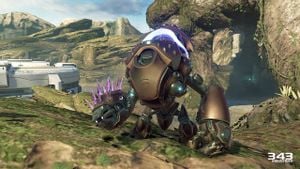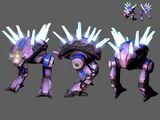Needle cannon: Difference between revisions
From Halopedia, the Halo wiki
BaconShelf (talk | contribs) m (BaconShelf moved page Heavy needle cannon to Needle cannon) |
m (→top: link change) |
||
| Line 1: | Line 1: | ||
{{Status|Canon}} | {{Status|Canon}} | ||
{{center|For the [[Enforcer]]'s twin needle-type weapons, see [[shard cannon]].}} | {{center|For the [[Enforcer]]'s twin needle-type weapons, see [[shard cannon]].}} | ||
[[File:H5G- | [[File:H5G-Grunt Goblin 1.jpg|thumb|right|300px|A ''Pnap''-pattern Goblin wielding a needle cannon mounted on its right arm.]] | ||
'''Needle cannons''' are a class of heavy mounted weapon typically used by the [[Covenant]] and its [[Covenant remnants|remnants]]. Needle cannons, as their name suggests, employ the use of [[Subanese crystal]] (or "Blamite") as their primary munitions. | '''Needle cannons''' are a class of heavy mounted weapon typically used by the [[Covenant]] and its [[Covenant remnants|remnants]]. Needle cannons, as their name suggests, employ the use of [[Subanese crystal]] (or "Blamite") as their primary munitions. | ||
Revision as of 13:44, April 9, 2023
Needle cannons are a class of heavy mounted weapon typically used by the Covenant and its remnants. Needle cannons, as their name suggests, employ the use of Subanese crystal (or "Blamite") as their primary munitions.
Overview
Needle cannons operate on the fundamentally same basis as most other needle weaponry; a large Subanese crystal is broken into needle-like shards, which are catalysed by a magnetic auger to fire. These weapons exhibit "predatory" tracking properties against their targets and explode upon impact.[1] Unlike their smaller forebears, needle cannons refer to heavy armaments mounted on vehicles, aircraft, and static turret emplacements. In this context, they are often used as anti-aircraft weapons, serving a similar role to the multiple-launch rocket systems favoured by the United Nations Space Command. Such usage includes as part of a modular upgrade package on the static Kewu Umppi'pa'-pattern citadel turret,[2] and as part of the air-air armament of the Bkowe'nei-pattern Vampire.[3][4][5]
The Pnap-pattern Goblin developed by the Unggoy employs a single needle cannon on its right arm in its most common configuration. These weapons are predominantly used for anti-infantry or anti-light vehicle roles.[6][7] This loadout is copied aboard the specialised variant of the Goblin developed by the Eklon War-Forges for the Banished, though the needle cannon is relocated to the left arm.[8]
Heavy needle cannons
Heavy needle cannons are a distinct class of weaponry apparently separate to standard needle cannons, though to date few specifics are known on how these systems are distinct to standard needle cannons. The only such observed example is the single heavy needle cannon mounted as the primary armament of the Bkowe'nei-pattern Vampire air superiority fighter used by the Covenant military.[4][3] The weapon fires dense shards of self-tracking Subanese crystal fragments, with the large crystals protruding out of the 360-degree rotational turret on the top of the craft.[5]
Usage
- Needle cannons
- Pnap-pattern Goblin - 1x needle cannon[6][7]
- Eklon'Dal Workshop Goblin - 1x needle cannon[8]
- Kewu Umppi'pa'-pattern citadel turret - 1x needle cannons, as part of an optional modular anti-air upgrade package.[2]
- Heavy needle cannons
- Bkowe'nei-pattern Vampire - 1x heavy needle cannon[5]
Production notes
Needle cannons are a fairly staple fixture of several cut Halo Wars units. These include the Gorgon, a bipedal anti-air walker with a heavy needler comprising its main body, and the Hydra - a cut aircraft with several large needles sticking out of the sides of its wings.
Gallery
- Web vampire.jpg
The T-29 Vampire with a heavy needle cannon in Halo Wars.
List of appearances
- Halo Wars (First appearance)
- Halo 5: Guardians
- Halo Wars 2
- Halo: Bad Blood
Sources
- ^ Halo Encyclopedia (2022 edition), page 294
- ^ a b Halo Encyclopedia (2022 edition), page 301
- ^ a b Official Halo Wars Community Site, Vampire (Retrieved on Mar 30, 2018) [local archive] [external archive]
- ^ a b Halo: The Essential Visual Guide, page 200
- ^ a b c Halo Encyclopedia (2022 edition), page 289
- ^ a b Halo Waypoint, Canon Fodder - Buzz Generating (Retrieved on Nov 8, 2020) [archive]
- ^ a b Halo Encyclopedia (2022 edition), page 277
- ^ a b Halo Encyclopedia (2022 edition), page 466



